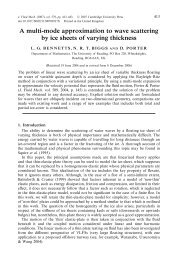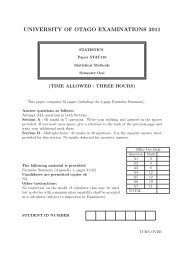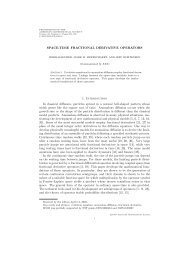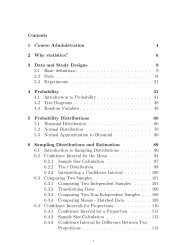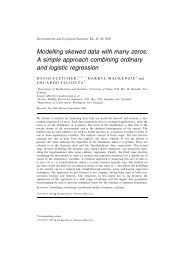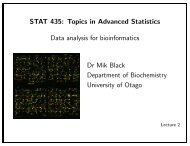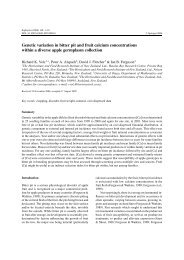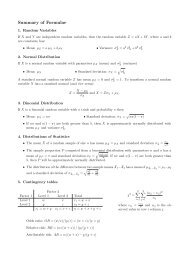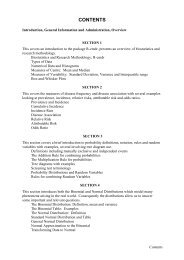Fractional reaction-diffusion equation for species ... - ResearchGate
Fractional reaction-diffusion equation for species ... - ResearchGate
Fractional reaction-diffusion equation for species ... - ResearchGate
Create successful ePaper yourself
Turn your PDF publications into a flip-book with our unique Google optimized e-Paper software.
4 Baeumer, Kovács, Meerschaert<br />
2 Problem outline<br />
The classical <strong>reaction</strong>-<strong>diffusion</strong> <strong>equation</strong> (1) and its fractional analogue (2)<br />
are both special cases of a general <strong>for</strong>m<br />
∂u<br />
∂t (x, t) = (Au)(x, t) + f(u(x, t)), u(x, 0) = u 0(x) (5)<br />
where A is a pseudo-differential operator [25] that appears as the generator<br />
of some continuous convolution semigroup [1,44]. Our goal in this section is<br />
to explore the connection between this continuous time evolution <strong>equation</strong><br />
and its discrete time analogue, the integro-difference <strong>equation</strong><br />
u n+1 (x) =<br />
∫ ∞<br />
−∞<br />
k τ (x, y)g τ (u n (y)) dy (6)<br />
where u n (x) = u(x, nτ) with some τ > 0 fixed. Our general approach is based<br />
operator theory <strong>for</strong> abstract differential <strong>equation</strong>s [1,20,44] and infinitely<br />
divisible probability distributions [21,36].<br />
Example 1 To demonstrate the basic idea let us consider the classical <strong>reaction</strong><strong>diffusion</strong><br />
<strong>equation</strong> (1) with a growth term f(u) = ru <strong>for</strong> some real r ≥ 0. It<br />
is well know that if r = 0 then the solution is given by<br />
u(x, t) =<br />
∫ ∞<br />
−∞<br />
1<br />
√ e − (x−y)2<br />
4Dt u 0 (y) dy := [T (t)u 0 ](x)<br />
4πDt<br />
where the dispersal operator T (t) maps the initial condition at time t = 0,<br />
the function u 0 (x), to the solution of the <strong>diffusion</strong> <strong>equation</strong> at time t > 0.<br />
Likewise, if D = 0 then the solution is given by<br />
u(x, t) = e rt u 0 (x) := [S(t)u 0 ](x).<br />
where the growth operator S(t) maps the initial condition to the solution of<br />
the growth <strong>equation</strong> at time t > 0. Clearly, [S(t+s)u 0 ](x) = [S(t)S(s)u 0 ](x) =<br />
[S(s)S(t)u 0 ](x) and [T (t + s)u 0 ](x) = [T (t)T (s)u 0 ](x) = [T (s)T (t)u 0 ](x) <strong>for</strong><br />
all t, s ≥ 0 (the semigroup property). Using the product rule its is easy to see<br />
that the solution to (1) is of the <strong>for</strong>m<br />
u(x, t) =<br />
∫ ∞<br />
−∞<br />
√ 1<br />
4πDt<br />
e − (x−y)2<br />
4Dt e rt u 0 (y) dy = [T (t)S(t)u 0 ](x) (7)<br />
= [S(t)T (t)u 0 ](x) = e rt ∫ ∞<br />
−∞<br />
√ 1<br />
4πDt<br />
e − (x−y)2<br />
4Dt u 0 (y) dy, (8)<br />
that is; the solution of the complex problem (1) can be written using the<br />
solution of the simpler sub-problems. Now if we fix τ > 0, then by (7) and<br />
(8) we have<br />
u n+1 (x) = u(x, (n + 1)τ) = [T ((n + 1)τ)S((n + 1)τ)u 0 ](x)<br />
= [(T (τ)) n+1 (S(τ)) n+1 u 0 ](x) = [T (τ)S(τ)(T (τ)) n (S(τ)) n u 0 ](x)<br />
= [T (τ)S(τ)T (nτ)S(nτ)u 0 ](x) = [T (τ)S(τ)u n ](x)<br />
=<br />
∫ ∞<br />
−∞<br />
√ 1<br />
4πDτ<br />
e − (x−y)2<br />
4Dτ e rτ u n (y) dy :=<br />
∫ ∞<br />
−∞<br />
k τ (x, y)g τ (u n (y)) dy.



